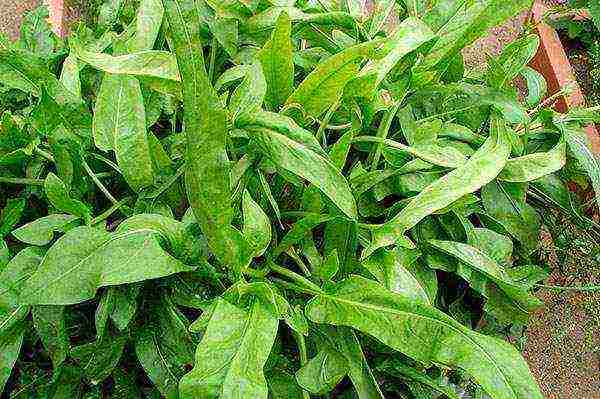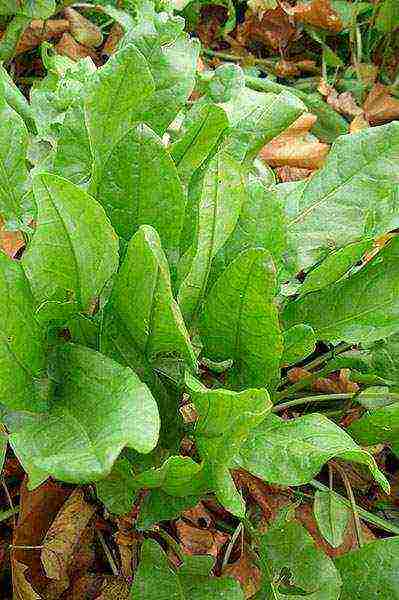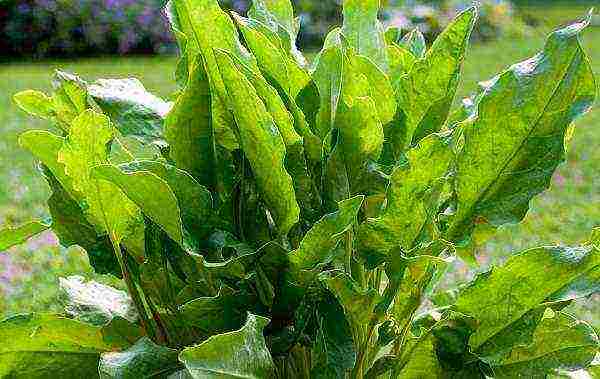Content
In spring and early summer, sorrel soup appears on the table. Many call it green cabbage soup. This delicious seasonal dish replenishes the body with vitamins, organic acids (malic, oxalic, citric) and minerals. Later, in hot summer, sorrel will acquire a number of qualities that are harmful to the body. It increases the concentration of oxalic acid. And this is fraught with sad consequences: the appearance of sand or kidney stones, gout, and so on. The correct name for the perennial sorrel we grow in our gardens is sour sorrel, or ordinary (Rumex acetosa). It belongs to the Buckwheat family.

Sorrel in the garden
Highly productive sorrel varieties have been developed, the seeds of which are sold in stores. They differ not only in the size and shape of the leaves, but also in some other features: taste, degree of resistance to flowering, winter hardiness, productivity, etc. There are even ornamental varieties of sorrel that can be used as a flower garden decoration and as edible greenery. It is recommended to renew sorrel crops every 3-4 years, later they degenerate. Growing scheme: 20 x 5 - 8 cm.
Variety "Belleville". This old variety is not inferior in quality to new products. Greens are rich in vitamin C, carotene and trace elements. The variety is frost-resistant. Leaves with thick petioles, they appear in early spring. During the season, it is possible to collect up to 7 kg per square meter. Sorrel has a universal purpose, i.e. its greens are used fresh, boiled and canned.

Sorrel
Variety "Emerald Snow". The valuable quality of this variety is its yield. From germination to collection of leaves, 46 - 52 days pass. The leaves are rich in vitamins (C, B group, carotene), organic acids. Seeds can be sown not only in spring and before winter, but even in summer. A raised, spreading rosette of ovoid, slightly bubbly leaves looks beautiful in the garden. The variety does not shoot for a long time. Productivity up to 7.5 kg per square meter. The leaves have such a pleasant taste that they are added to green salads and made into soup. The leaves are salted, canned and frozen for the winter.
Variety "Malachite". This winter-hardy early-ripening variety amazes with the growth rate of beautiful green leaves with wavy edges. It takes only 40 - 45 days from germination to leaf cutting! Leaves, 12-15 cm long, are collected in an erect loose rosette. Their surface is smooth or slightly bubbly.
Variety "Odessa broadleaf". The winter-hardy early-ripening variety gives a full harvest of leaves within 45 days after germination. Dark green elongated ovate leaves (up to 16 cm long, 7 cm wide) are collected in a loose erect rosette. Productivity (3 - 8 kg) depends on growing conditions to a greater extent than that of other varieties. The leaves are suitable for salads, soups and winter preparation. They contain a lot of vitamins, iron and potassium.
Variety "Shirokolistny". The variety is becoming popular and is often preferred over other varieties. It gives a harvest of greens already 40 - 45 days after germination. Elongated ovate leaves are kept on a long petiole. Productivity up to 8 kg per square meter. The taste of the leaves is slightly acidic, so sorrel is good for salads. It is a winter hardy variety. In hot, dry summers, it is strongly arrowed. Can be grown in one place for 4 - 5 years. The last cut is carried out in mid-August. This period gives a margin of time so that the bushes can prepare for the winter.
Variety "Large-leaved". This is one of the earliest varieties (30 - 45 days from germination to mass harvest). I like it more than the others because of the pleasant taste of the light green leaves. High frost resistance. The cultivar is considered to be relatively resistant to stem stemming.
Varieties "Maykop 10" and "Spinach" early maturing, their feature is a low acid content. Hardy enough.
Variety "Altai". It has spear-shaped leaves on thin long petioles. At first, young leaves are dark green, then they have a reddish tint. The taste of greens is moderately acidic and sour (according to various estimates). High frost resistance.
Lyons variety. This is a rather vulnerable variety in our climate, which can freeze out or dry out in unfavorable winters. It is a pity, since this is really the kind that can be praised for the high quality and excellent taste of the greens. Fleshy leaves and thick stalks grow quickly, so cutting is done several times per season.
Variety "Bloody Mary" refers to decorative. This is a novelty worth taking a closer look at. The leaves are decorated with a pattern of burgundy veins. You can collect leaves (length up to 15 cm, width up to 10 cm) from a beautiful bush 45-50 days after germination. Cutting is done several times during the season. The variety is winter-hardy. Spectacular leaves are admired not only in the flower garden, but also in ... salad. A delicious soup is prepared with them, they are salted.
Variety "Red veins". Another decorative variety of common sorrel. A bush about 40 cm high is decorated with spear-shaped green leaves with burgundy-red veins. The leaves are collected in an upright compact rosette. Flowers are small, collected in inflorescences. Actively growing sorrel is recommended to be planted among stones or in mixborders. Better on nutritious soil with regular moisture. The brightest pattern appears on the leaves of those bushes that grow in a sunny place or with a little shade. They acquire a less expressive color in the shade. Seeds can germinate for a long time (up to 3 weeks), so it is recommended to grow the variety through seedlings. It is planted in a permanent place with an interval of 30 - 40 cm. Only young leaves are used for food, until they are coarse.

Sorrel in the meadow
♦ Heading: Garden and vegetable garden.
♥ Tags: sorrel
Do you like fresh and juicy greens? This is understandable, because it contains many useful substances. Sorrel appears first in the garden, so we will consider those varieties for open ground that are in greatest demand among gardeners. A perennial herb that can withstand even low temperatures, does not require special care.

Sorrel leaves are used to prepare first courses, such as borscht, cabbage soup, soups, and they are also used for filling for pies.
The best varieties of sorrel for open ground, reviews
The height of the plant reaches no more than 100 cm. On one it grows for a maximum of 4 years. The optimum temperature for germination of sorrel seeds is +3 degrees. In cooking, the leaves are used to prepare first courses, such as borscht, cabbage soup, soups, and they are also used for filling pies.
What, according to reviews, are the best varieties of sorrel for open ground? Here are some of them with photos and descriptions:
1. Belvian... This is one of the best early yielding varieties. Its leaves are very delicate, have a slightly acidic and pleasant taste. This type of crop is resistant to stem stemming and quite frost-resistant.
2. Spinach... Medium early variety with large leaves, as seen in the photo. Has an upright power outlet. Dark green leaves are characterized by a high content of vitamin C. The greens of the variety are slightly acidic. Leaves grow back quickly.
3. Odessa broadleaf... The plant is dark green in color, it stands out for its drought resistance, and resistance to low temperatures. Recommended for outdoor cultivation. Suitable for canning and fresh use.
4. Sanguine... It takes about 43 days from its germination to the first collection of greens, therefore it belongs to the early maturing. The leaves are large, ovoid. Average yield - 5 kg per 1 sq. M. It is grown not only in protected, but also in the open field.
Sorrel: planting, cultivation, outdoor care
Sorrel: the best varieties for the Moscow region
This culture has long been famous for its beneficial properties. She gained popularity also due to the fact that it does not require care from the summer resident. In the Moscow region, you can often see sorrel leaves. Therefore, pay attention to the best varieties:
• Malachite - mid-early grade. The first crop is harvested approximately 50 days after germination. The weak and delicate taste will not leave indifferent not only gardeners, but also housewives. The spear-shaped form of leaves with wavy edges also attracts attention.
• Green fairy tale... This is a mid-early variety that is considered relatively new in comparison to the previous ones. Suitable for home cooking, preservation, the leaves are used fresh. On one site, it can be grown for no more than 5 years. The leaves grow rapidly, which cannot but please summer residents.
• Champion... For 2 cuts from 1 square meter, you can collect 6.5 kg of leaves. Not every variety can boast of such indicators. The diameter of the rosette is 30 cm. Its petioles are of medium length. The champion is distinguished by its incredible slightly acidic taste.
Video about sorrel varieties for open ground:
Top varieties of sorrel for open ground are discussed in detail in the article. Here you can not only learn more about them, but also see photos, descriptions, read reviews. When you get complete information, you can make an informed choice in favor of the best grade.
(
estimates, average:
out of 5)
Sorrel already in early spring pleases us with a harvest of vitamin greens. This culture is not afraid of low temperatures and is very unpretentious.
Sorrel varieties by ripening time
Sorrel varieties
Early sorrel yields greens 40-45 days after pecking the leaves. This category includes varieties:
• Spinach
• Broadleaf
• Sanguine
• Emerald Snow
• Belleville
• Malachite
• Emerald King
Description of the variety Sanguine
Sorrel variety Sanguine
The harvest of the leaves will have to wait only 40-45 days. Plant height is 30 cm. Smooth, large, green leaves have reddish veins. The stem is colored red-yellow. The leaves have a pleasant, slightly acidic taste.
Average ripening times are inherent in varieties:
• Maikop 10
• Champion
• Bloody Mary
Description of the Champion variety
Sorrel variety Champion
The erect rosette of the plant reaches a diameter of 30 cm. The height of the aboveground part is about 40 cm. The shape of green leaves is elongated-oval, the petioles are of medium height. The edges of smooth large leaves are slightly wavy. Taste characteristics are good (juicy leaves have a moderately sour taste). The yield is very high.
Sorrel varieties for central Russia
Early, mid-early and mid-season plants can be grown in central Russia. It is especially worth highlighting such varieties as:
• Green fairy tale
• Maikop 10
• Abundant
• Spinach
• Broadleaf
• Sanguine
• Emerald Snow
• Belleville
• Champion
• Emerald King
• Malachite
• Lyons
• Bloody Mary
• Red veins
Description of the Belleville variety
Sorrel variety Belleville
Plants give an early harvest of greenery. The leaves are oval-elongated. They are colored light green. The variety is resistant to flowering. The yield is very high.
Decorative varieties of sorrel
Some sorrel varieties not only produce edible leaves, but also look very impressive on the beds. The most popular are plants with reddish veins:
Sorrel variety Bloody Mary
• Bloody Mary (medium-sized green leaves are decorated with burgundy veins, the variety is highly winter-hardy).
• Red veins (spear-shaped green leaves have burgundy-red veins, which are brighter, the more sunny place is chosen for growing the plant).
The best sorrel varieties for Siberia
Sorrel can withstand low temperatures - seeds germinate already at 2-3 degrees Celsius. Leaves begin to grow actively at 15-16 degrees. The following varieties are grown in Siberia:
• Belleville
• Maisky
• Maikop 15
• Altai
Description of the Altai variety
Plants of this variety have spear-shaped leaves. Their color changes as they grow - the dark green leaves acquire a reddish tint. The variety is characterized by high frost resistance. The taste of the leaves, depending on the growing conditions, can be either slightly acidic or sour.
Sorrel varieties differ in both external characteristics and taste. Plants are unpretentious and productive - early greens can delight you for three or four seasons (older plantings should be renewed, as the plants gradually weaken).
Belleville
Medium early grade.
The socket is raised, spreading.
Leaves are light green, smooth or slightly bubbly, large, fleshy, ovate, 13–15 cm long, 5–10 cm wide.
The taste of the leaves is pleasantly slightly acidic.
Petioles are thick, of medium length.
Frost resistant.
Large-leaved
An early ripe fruitful variety.
The socket is standing.
Leaves are light green, oval-elongated, 10-14 cm long, 6-10 cm wide.
Resistant to low temperatures.
Malachite
Medium early grade.
The period from germination to the first cut is 45-50 days.
Leaves are spear-shaped, smooth, with wavy edges.
The petioles are long.
The taste of the leaves is slightly acidic.
Odessa 17
An early ripe drought-resistant variety.
The socket is raised, spreading.
Leaves are elongated, oval, 12-16 cm long, 6-8 cm wide.
Stalk resistant.
Broadleaf
Winter-hardy fruitful variety.
Leaves are green, medium-sized, ovoid, 12-15 cm long, 6-8 cm wide.
The taste of the leaves is delicate, moderately acidic.
Resistant to shooting.
Spinach
Medium early grade.
The socket is upright, loose.
The leaves are dark green, slightly bubbly, large, with a high content of vitamin C.
The taste of the leaves is slightly acidic.

